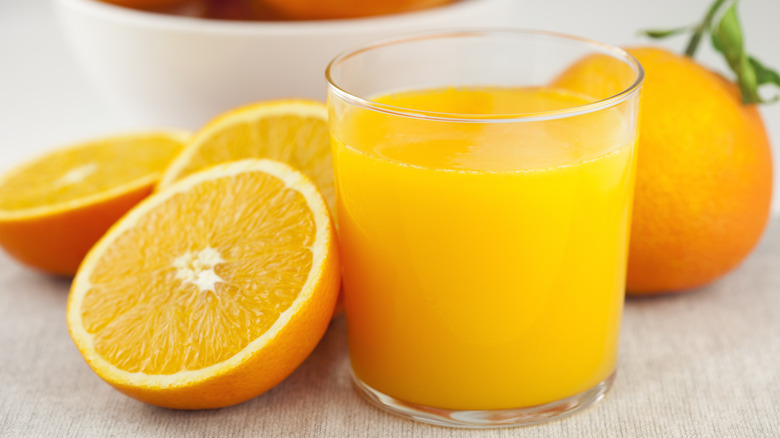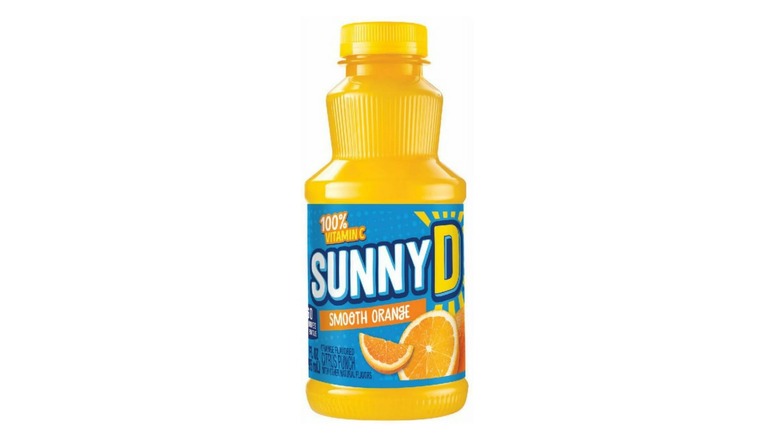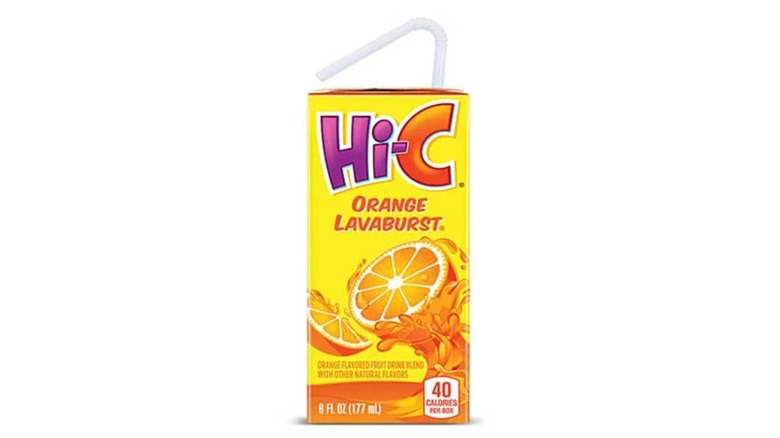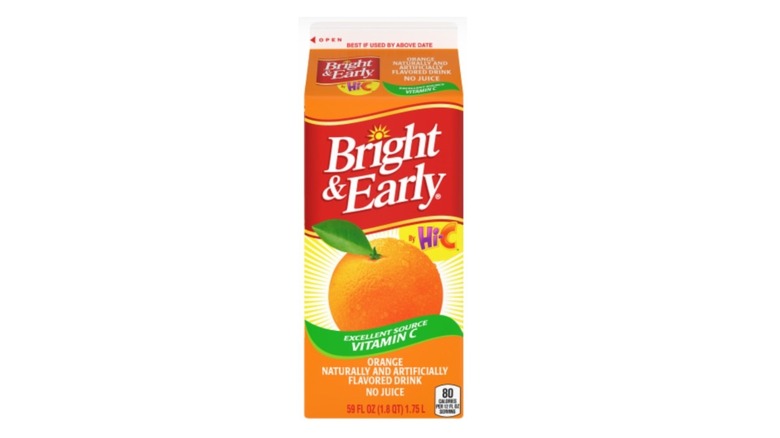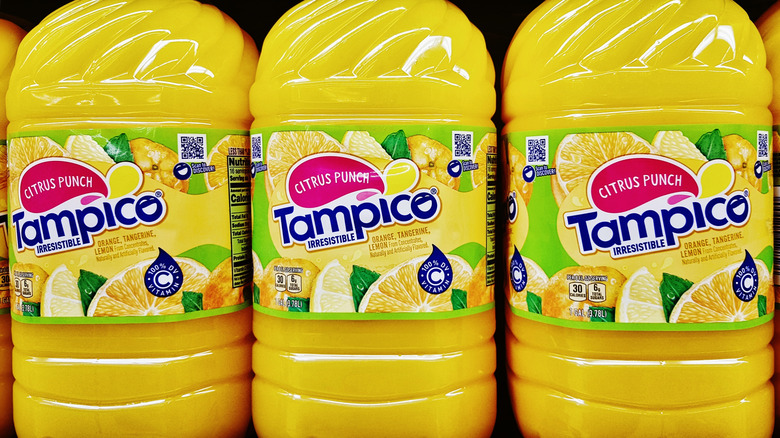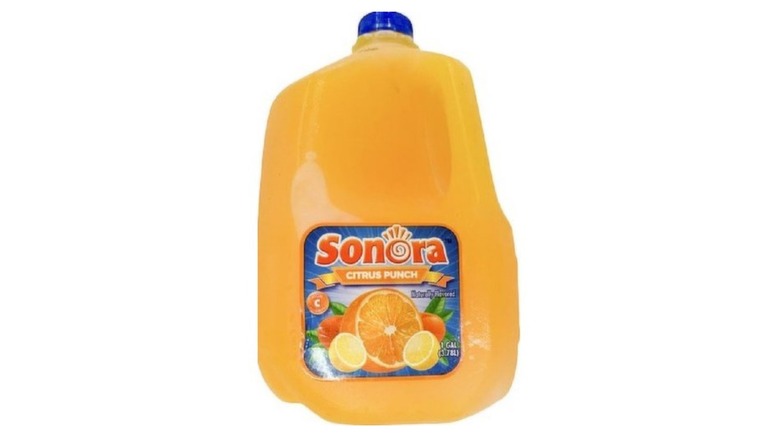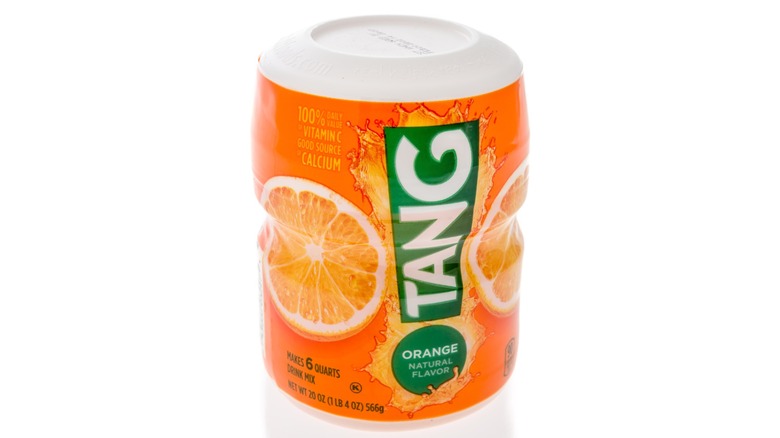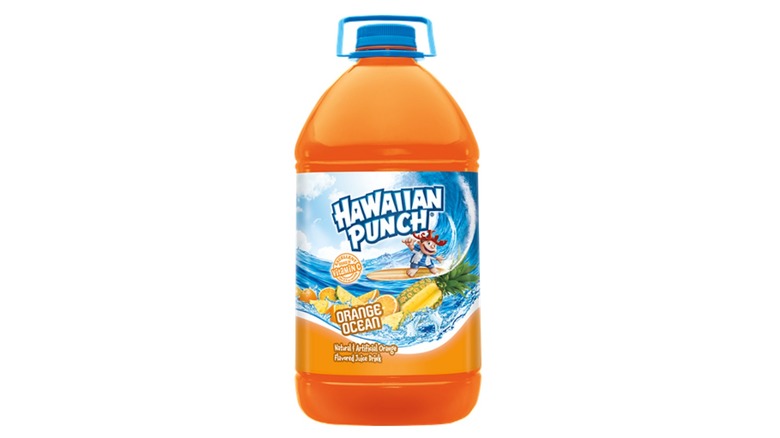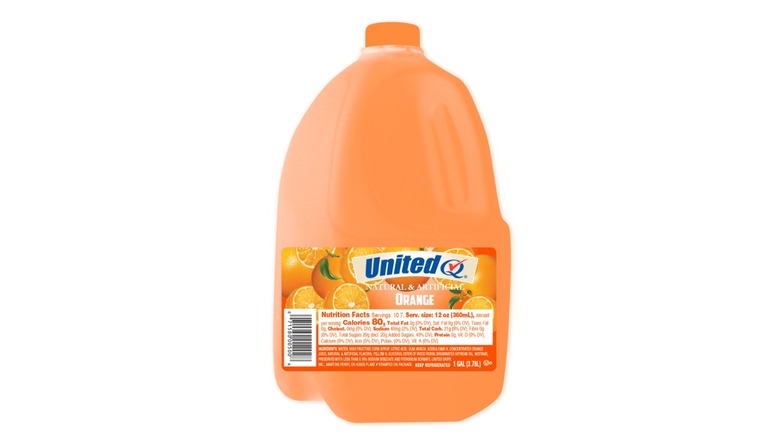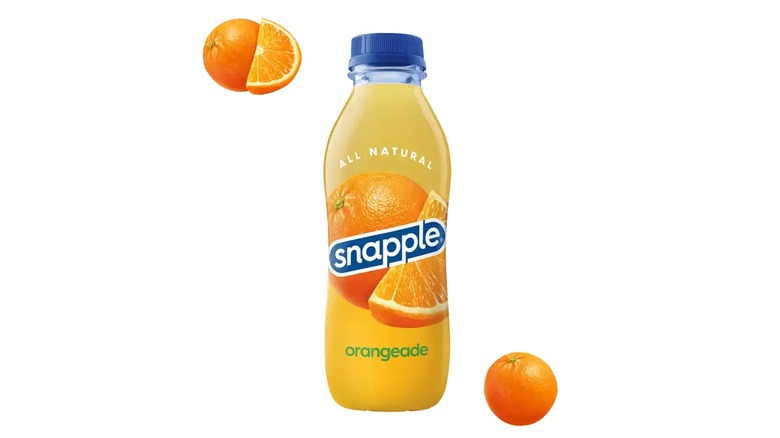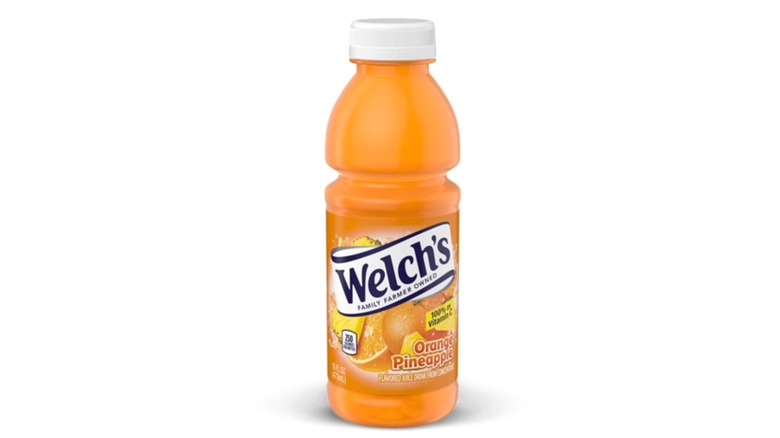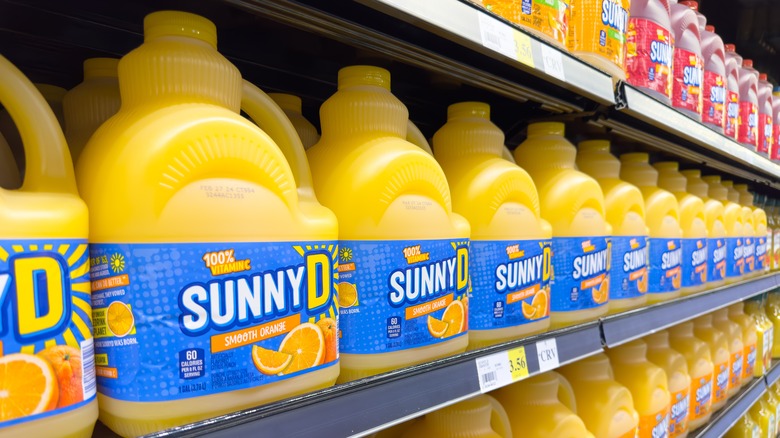10 Unhealthiest Store-Bought Orange Juices
We may receive a commission on purchases made from links.
There's no doubt that orange juice is a staple at any breakfast table. But unless you squeezed the oranges yourself, take a closer look at the bottle. You may be surprised to find out that there's a lot more in your juice than just oranges and water. In some cases, the sugar content rivals that of soda.
Many store-bought beverages that look and taste like orange juice aren't actually orange juice. Or, at least not officially. According to the FDA, pasteurized orange juice must contain at least 10.5% of soluble solids from oranges. Orange juice from a concentrate needs to have at least 11.8%. These solids refer to the natural sugars, liquid, and any other parts of the fruit that make up the juice. Any drink that doesn't meet these standards can't have orange juice on its label. Instead, many of these beverages call themselves "orange drink" or "orange-flavored." However, many consumers still treat these beverages like orange juice.
To help shoppers make more informed decisions, we put together a list of some of the most unhealthy "orange juices." Note that while these beverages aren't technically orange juice, many still market themselves as such. We looked for any that contain added sugars, fillers, and artificial coloring, but more on this later (see the methodology section). So, if you don't have time to make your own fresh orange juice, here's a cheat sheet of the ones to avoid at all costs.
1. SunnyD Smooth Orange
Back in the day, it seemed no play date or school lunch was complete without bottles of SunnyD in hand. But what you might not have realized is that what makes SunnyD so tasty is the fact that it's basically liquid sugar. Containing only 5% juice, SunnyD is below the threshold to legally call itself orange juice.
The flavor Smooth Orange, the most similar in taste to orange juice, contains 10 grams of added sugar per 8-ounce serving. Note that the FDA recommends consuming no more than 50 grams of added sugar per day (based on a 2,000-calorie diet). Forget the pancakes and maple syrup 一 one serving of SunnyD at breakfast already fulfills 20% of your daily allotment of added sugar. While this might not seem like a lot, keep in mind that the FDA considers the content to be high if it meets or exceeds 20% of the recommended daily value for that nutrient.
How is there so much sugar? Looking at the label, high fructose corn syrup is the second ingredient after water. This sugar water then contains less than 2% of concentrated orange and other fruit juices. You'll also find sucralose, an artificial sweetener that most people might know as Splenda. To top it all off, artificial coloring helps the drink achieve its signature orange color. Widely available at stores nationwide, Sunny D remains a popular orange juice alternative, though its sugar levels make it more suited to dessert than breakfast.
2. Hi-C Orange Lavaburst
Owned by the Coca-Cola Company, Hi-C is another drink that's more sugar than juice. The flavor Orange Lavaburst is described as a mix of orange and apple juice. However, after water, this juice lists high fructose corn syrup as its main ingredient, and the numbers back this up.
One serving of the drink, equivalent to 6 fluid ounces, packs 10 grams of added sugar. Given the FDA's recommended daily limit, this is nothing to balk at. The American Heart Association has even stricter advice when it comes to added sugar. The group recommends that men should consume no more than 36 grams and women no more than 25 grams per day to stay healthy.
In addition to high fructose corn syrup, this drink contains sucralose and acesulfame potassium, both artificial sweeteners. While the FDA has declared acesulfame potassium safe to eat, according to Healthline, some studies have linked the sweetener to hormone disruption and the development of cancer.
In terms of pros, Hi-C does provide all the vitamin C you need in a day. But don't get too excited 一 while many 100% orange juice options come fortified with vitamin D, Hi-C offers little in the way of this vitamin. Orange Lavaburst can be found nationwide at major retailers such as Safeway and Walmart.
3. Bright & Early Orange Flavored Drink
Developed by Hi-C, Bright & Early is a juice line that can be found at major grocery stores, including Kroger and Walmart. Bright & Early's Orange Flavored Drink comes in cartons that look like any other orange juice on store shelves. However, this is a bit misleading because Bright & Early isn't technically orange juice.
Much like Hi-C, the first two ingredients on the label are water and high fructose corn syrup. You won't find any real oranges here, which is why you'll find the phrase "Orange Flavored Drink" on the label. It's a "juice" with natural and artificial flavors, where citric acid provides the acidity that oranges would normally contribute.
Even worse than the complete lack of oranges is the sugar content. Per 12 fluid ounce-serving, this juice carries 17 grams of added sugar. That's more than a serving of Hi-C. It's also 34% of the FDA-recommended daily intake of added sugar. Why is too much sugar a bad thing? A diet high in excess sugar can lead to the development of heart disease, diabetes, obesity, and fatty liver disease, among other issues.
In the U.S., soft drinks and fruit drinks are among the top sources of added sugar in our diets. This is why it's so important to read the labels. Instead of Bright & Early, look for orange juice with no added sugar.
4. Tampico Citrus Punch
A gallon of Tampico Citrus Punch may look like regular orange juice, but it's far from it. The drink features a long list of ingredients, beginning with water and high fructose corn syrup. While it does contain actual fruit juice from concentrate, there's less than 2% orange juice per serving. If you're wondering what else is in this drink, know that it isn't all good. In an 8-ounce glass of Tampico, you'll consume artificial coloring and preservatives such as potassium sorbate. And then there's, again, the sugar.
A serving of Tampico contains 6 grams of added sugar. This might not be as high as other orange drinks, but this doesn't mean that it's a healthier choice. In addition to high fructose corn syrup, you'll also find artificial sweeteners. This includes sucralose, which is generally considered safe to consume. However, the drink also contains acesulfame potassium and neotame, artificial sweeteners that may cause health problems. Studies have shown that neotame can cause harm to the gut, making it something you may want to limit. Sold at major grocery stores like Safeway and Walmart, Tampico at least provides the daily recommendation for vitamin C, if nothing else. Though we might recommend skipping this one altogether.
5. Sonora Citrus Punch
Available at Smart & Final and other retailers, Sonora Citrus Punch comes in a gallon just like other orange juices. However, Sonora Citrus Punch doesn't actually contain any juice at all. Instead, this drink is a mixture of water, high fructose corn syrup, preservatives, and artificial sweeteners. The signature citrus flavor comes from citric acid and sodium citrate, chemicals known for their tart, sour taste.
Like other orange drinks on this list, Sonora Citrus Punch contains the artificial sweetener sucralose. Unfortunately, you'll also find acesulfame potassium and neotame, which can have harmful effects on the body. Another concerning addition is sodium benzoate, a preservative that's been linked to several health issues. Notably, sodium benzoate can convert into benzene, a known carcinogen. This change is more likely to occur in beverages that contain both sodium benzoate and vitamin C (also known as ascorbic acid). While the presence of vitamin C is normally a good thing, in this case it's potentially harmful.
An 8-ounce glass of Sonora Citrus Punch will contain 12 grams of sugar, or roughly ¼ of your daily recommended amount, per the FDA's guidelines.
6. Tang
Tang is a little different from other orange drinks on this list. It comes in powder form, packed in a small container with instructions that simply explain to mix it into water. For many of us, Tang was the orange juice we grew up with, the refreshing flavor on hot summer days. However, Tang wasn't always a hit. It struggled to connect with consumers when it was introduced in 1959. But this would change when NASA brought it onto space flights and astronauts began drinking the powdered drink in place of orange juice. In the 60s and beyond, the brand's popularity soared.
Far from the product of anything resembling an actual orange, Tang is made from sugar, and a lot of it. One serving of the stuff 一 3 tablespoons dissolved in 12 fluid ounces of water 一 packs 34 grams of added sugar. That's 68% of the daily value for added sugar, gone in just a few sips. This exceeds the American Heart Association's recommendation of no more than 25 grams of added sugar per day for women. It's just shy of the 36-gram limit for men.
The first ingredient in Tang is sugar, followed by fructose 一 another form of sugar. Citric acid is responsible for that infamous tangy flavor, and artificial coloring achieves the expected yellow-orange hue. A serving of Tang does provide some benefits in the form of vitamin C and calcium, but there are much healthier, tastier ways to fulfill these needs.
7. Hawaiian Punch Orange Ocean
Hawaiian Punch may conjure up images of its carefree surfing mascot, embellishing the packaging on bottles of impossibly red, tropical-flavored juice. But the popular brand has other brightly colored flavors, including Orange Ocean, a mix of orange, pineapple, apple, and passionfruit juice. But while this sounds like a delicious combination, actual fruit juice only makes up less than 2% of the beverage.
Instead, the main two ingredients in Orange Ocean are water and high fructose corn syrup. As a result, one serving of the juice (8 fluid ounces) contains 10 grams of added sugar. As a reminder, the FDA recommends consuming no more than 50 grams of added sugar per day.
A glass of Hawaiian Punch takes a considerable chunk out of this allowance. Unfortunately, it doesn't offer much in return, as one serving of the juice fails to provide enough vitamin C to meet the recommended daily amount set by the FDA. What's more, you'll also be ingesting sucralose, artificial coloring, preservatives, and other food additives. In comparison, a cup of 100% orange juice provides the day's required amount of vitamin C and then some, with none of the unwanted extras. You can find Hawaiian Punch Orange Ocean at many major grocery store nationwide.
8. United Dairy orange flavored drink
Depending on your location, United Dairy's orange-flavored drink may be a little more difficult to find. The brand mainly sells its products at stores in the tri-state area, with offerings that include milk, cottage cheese, ice cream, and iced tea. Also on this list is orange juice. Or, in this case, orange drink. Contrary to the orange juice that it appears to be, this beverage has very low nutritional value. You might reasonably expect to find vitamin C in any orange juice or drink, but that's not the case here. You also won't find any vitamin D.
Now onto what makes this drink so unhealthy. One 12-ounce serving contains a whopping 20 grams of added sugar, which comes out to 40% of the daily value for the nutrient. This means that drinking just one glass already fulfills almost half the amount of added sugar that anyone should eat in one day. Taking a closer look at the label, the high sugar content makes sense. After water, high fructose corn syrup is the main ingredient. This is followed by ingredients like concentrated orange juice, citric acid, and natural and artificial flavors. Less savory additions include the dreaded preservative sodium benzoate and artificial sweeteners such as neotame.
This orange drink is better thought of as a punch, to be sipped on special occasions. A healthier alternative for everyday breakfast would United Dairy's 100% pure orange juice, which has no added sugars, sweeteners, or preservatives.
9. Snapple Orangeade
Sold everywhere from mass retailers to convenience stores, Snapple is well loved for its sweet iced teas and bottled juices. At first glance, Snapple's Orangeade looks all right. It contains real orange juice and doesn't have high fructose corn syrup, harmful preservatives, or artificial sweeteners. Beta carotene, a plant-based pigment and source of vitamin A, adds some color in lieu of artificial dyes.
However, the sugar content earns it a place on this list. After water, the main ingredient on the label is sugar. One serving of Orangeade, the equivalent of one 16-ounce bottle, packs 39 grams of added sugar 一 79% of the FDA-set daily value. To help you visualize just how much this is, imagine a teaspoon of sugar. Now, picture 10 teaspoons of sugar. Just under 10 teaspoons of added sugar go into a single bottle of Snapple Orangeade.
To make matters worse, this drink is only 10% juice. In addition to the water and sugar, other ingredients include citric acid and acacia gum, a natural stabilizer. As an alternative, Snapple does have a zero sugar line of products, but there are currently no orange-based options.
10. Welch's Orange Pineapple
Known for its jams, jellies, juice, and fruit snacks, Welch's has been a mainstay in grocery stores and markets across the nation since it was established in 1869. Beyond Welch's tasty white grape or cranberry juice, the brand also offers a blend of orange and pineapple juice. However, unlike the majority of Welch's drinks, Orange Pineapple is not made with 100% fruit juice. Instead, high fructose corn syrup is the leading ingredient after water. Citric acid and natural flavors contribute to the overall taste alongside fruit juice from concentrate.
Now for the ugly: One serving of Welch's Orange Pineapple, the size of a 16-ounce bottle, contains an astonishing 54 grams of added sugar. This manages to exceed both the AHA's and FDA's recommended limits, landing anyone who drinks the whole bottle at over 100% the daily value. To put things into perspective, one serving of Sunkist Orange Soda Pop carries 44 grams of added sugar. While this is a lot of sugar, it's something we generally expect when it comes to soda. What people might not expect is a fruit juice that has more added sugar than soda.
This isn't to say go ahead and drink a glass of orange soda. After all, Welch's Orange Pineapple is still a source of vitamin C while Sunkist isn't. However, there are much better, less sugary options out there if you're in the mood for orange juice.
Methodology
To determine our list of the unhealthiest store-bought orange juices, we looked at the nutrition labels of different juices available at grocery stores, supermarkets, and large retailers. Since many of these options do not fit the legal definition for fruit juice given their low juice content, we considered any beverage that might fall into a looser categories of orange juice or orange drinks.
We deemed a juice unhealthy if it does not contain 100% fruit juice and is instead formulated with added sugars, preservatives, food coloring, or other additives. Anyone seeking healthier alternatives should look for orange juices that are made from 100% juice, with zero added sugar or other ingredients.
